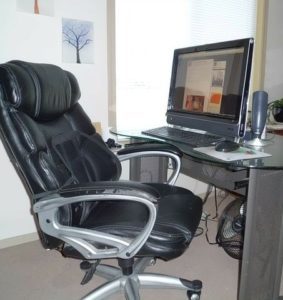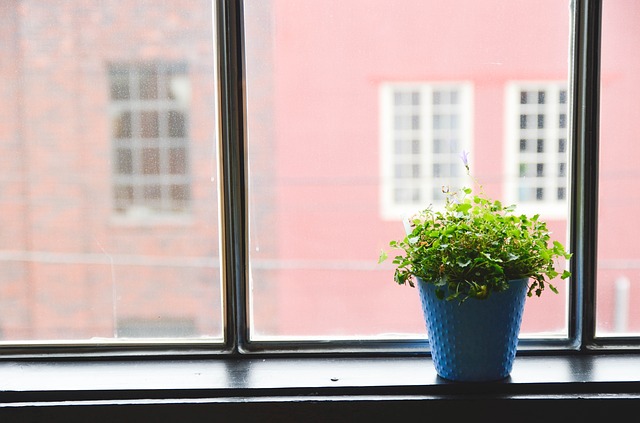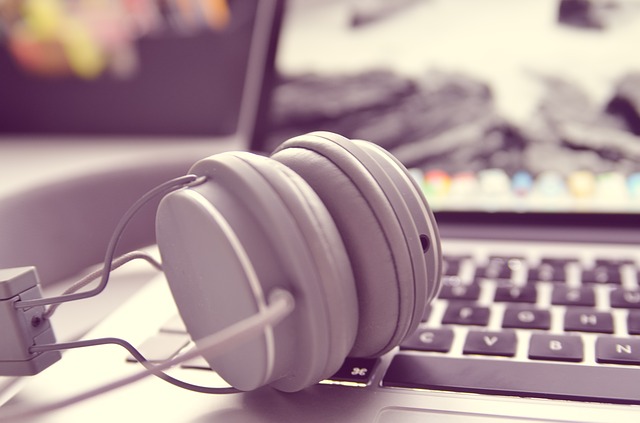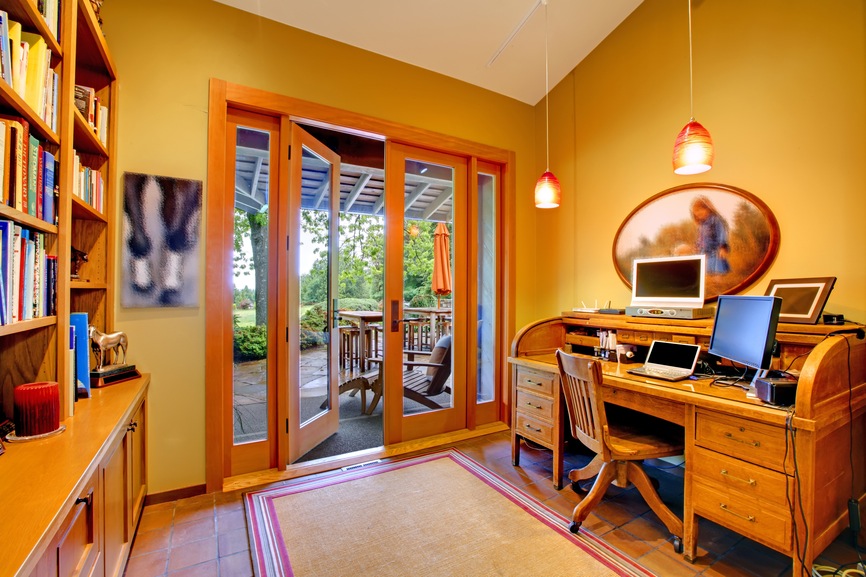Do you need to change your work area?
You may not have thought much about it, but it’s important.
Really important.
Did you know that certain things about your writer’s nook can actually make you stressed out or sleepy?
Other things can cause you headaches, make you less productive, or distract you from your work.
If you do it right, though, your home office, writer’s corner, artist’s studio, or whatever you call it, can actually stimulate your creativity and help you get more done.
You don’t have to spend a lot of money, either. Simple changes can make a world of difference in how well your creative time goes.
Your Environment Matters More Than You Think
Writers often take pride in the fact that they can do their work pretty much anywhere. But having a place where you can go on a daily basis that feels comfortable, inviting, and inspiring can help you get a lot more done.
Several studies have found that a comfortable work atmosphere can have a big impact on productivity.
In 2002, for example, researchers found that better temperature control, lighting conditions, and even reduced contaminants in the air increased productivity by nearly ten percent.
In 2009, researchers discovered that color can make a big difference, too. Participants worked on screens that were red, blue, or white.
The color that most enhanced creative activity? Blue—it prompted participants to produce twice as many creative outputs as when under the red color condition.
Change Your Work Area to Boost Creativity
Even high ceilings can help. Researchers found that when people were in a room with 10-foot ceilings, they tended to think more freely and abstractly.
“A reading and writing room is a little different from a traditional office,” says writer Emilie Sonnebogen. “This room is for someone who is serious about getting things done, without the distractions that a home office entails—phones, faxes and anything else that can interrupt your focus. If you’re a novelist or an editor, or even just a voracious reader, then you will benefit from creating a place in your home of complete serenity and isolation.”
Spring gives us an excuse to spend some time on this important area. It’s not self-indulgent—the more you can do to make your writing flow, the easier your work will be.
“Create a space for yourself that triggers reverie and encourages you to imagine and dream,” says author Phil Cousineau in Stoking the Creative Fires: 9 Ways to Rekindle Passion and Imagination. “Establish a space where your mind can travel down irrational and illogical paths.”
How do you do that? Start with these seven steps and your own creativity will take you from there.
7 Ways to Change Your Work Area for the Better!
 1. Make sure your chair is the best!
1. Make sure your chair is the best!
“When you get into your chair it should be like a pilot getting into his cockpit,” says novelist Henning Koch. “As you’ll be creating new worlds in this chair, make sure you love easing yourself into it every morning.”
Though finding just the right chair can be tough, it’s more important than you may realize.
Those of us who work long hours sitting down run a higher risk of back injury, and that risk increases as we get older.
“To avoid developing or compounding back problems,” write the good folks at Spine-Health.com, “it’s important to have an office chair that’s ergonomic and that supports the lower back and promotes good posture.”
This may be your most important piece of equipment in your office, so please feel right about spending a little more if you need to. Too many writers suffer from back pain—a good chair can save you a lot of problems in the future. If yours doesn’t feel wonderful to sit in, consider upgrading.
Here are a few things to look for:
- Adjustable seat height so you can rest your feet flat on the floor.
- Lumbar (lower back) support.
- Good cushioning in the seat.
- Adjustable arm rests.
- Something that feels good to you—everyone is different.
Change Your Work Area Tip 2. Take the lighting down.
If you can get some natural light into your office space, do so. It’s best for your eyes and for your creativity.
In a recent study, researchers found that participants exposed to natural light during the day were more alert at the beginning of the evening, while those exposed to artificial light felt sleepier. Artificial light has also been linked to increased feelings of stress.
 Make sure that any other lights aren’t too bright, as well. In 2013, German researchers reported that dim lighting sparked creativity. The difference was startling—those in a dimly lit room solved significantly more creative problems than those in a brightly lit room.
Make sure that any other lights aren’t too bright, as well. In 2013, German researchers reported that dim lighting sparked creativity. The difference was startling—those in a dimly lit room solved significantly more creative problems than those in a brightly lit room.
Bright overhead lights are also bad for your eyes. They dry them out more quickly. Turn off the fluorescents and use lamps instead. (If you’re stuck with fluorescents, remove one of the bulbs so they’re not so bright.)
Lamps are best positioned so they shine on the desk (not you) with the glow coming from the side, preferably behind you. Move the computer when you notice glare from windows.
3. Consider new colors.
Colors have a direct effect on mood. If you have an area you can play with, consider updating the color on your walls. Even if you can’t paint, pictures or even swaths of fabric can help bring some much needed variety into your space.
The following guidelines may help when you’re choosing what color to use:
Blue makes you more productive, and enhances clarity. For many, it tends to be better for left-brain tasks, like editing. It can also feel expansive, though, and encourage contemplation.
Yellow lifts your spirits, and makes you feel more optimistic. It also helps you stay more alert. For some, though, it may bring out too much liveliness, which can make it difficult to focus. It may be perfect for a brainstorming session, though. Consider splashes of yellow in pictures or furniture to balance it out.
Orange is also an uplifting color, and may make you feel more confident.
Red stimulates you physically, so it’s probably not the best color for sitting and writing. It can also make you irritable.
Pink has a calming effect and can even reduce appetite! If you frequently munch while working, some pink may help you cut calories.
Green is balancing, calming, and reassuring, as well as refreshing. One study found that it helped enhance creative performance. If you often face doubt on the page, green might be the shade for you.
Purple and indigo can help stimulate the imagination and intuition—perfect for first drafts.
White brings a feeling of openness and freedom. Too much can feel cold, clinical, and isolating, though, so if you want to use white, consider using it with another color.
Black can make you feel strong and tough. If you’re writing a thriller or want to get into the skin of a strong character, a bit of black could help. If you don’t want to make a permanent change, consider black drapes—they could work even over a section of the wall, just to give you that dark feeling.
Highly saturated colors (darker or deeper) are more stimulating, while pale, more pastel colors are more soothing.
 There’s no one color that’s best for everyone. For most, a combination is best. Maybe green walls with yellow-framed pictures, for instance, or white walls with purple accents or drapes. Use your imagination to make the colors more conducive to your creativity and your particular projects.
There’s no one color that’s best for everyone. For most, a combination is best. Maybe green walls with yellow-framed pictures, for instance, or white walls with purple accents or drapes. Use your imagination to make the colors more conducive to your creativity and your particular projects.
Change Your Work Area Tip 4. Check the temperature.
Even if you’re trying to save money by keeping the heat down in your work area, realize that being cold can severely affect your work.
According to a study out of Cornell University, employees made 44 percent more mistakes when the temperature was 68 degrees Fahrenheit (22 degrees Celsius) than they did when it was 77 degrees Fahrenheit (25 degrees Celsius).
Researchers noted that when it’s cold, you feel distracted, and can’t put all your focus on your work. Writers and artists need to focus, so make sure the temperature is comfortable.
Performance suffers in similar ways if you’re too hot, so as we move into summer, make sure you have fans and other cooling devices if you need them.
5. Reduce air pollution.
The EPA says that indoor air pollution is a lot more dangerous than outdoor: “Indeed, studies of human exposure to air pollutants by EPA indicate that indoor levels of pollutants may be 2 to 5 times – and occasionally more than 100 times – higher than outdoor pollutant levels.”
They add that indoor air pollutants are ranked among the top five environmental risks to health.
Here are just some of the ways air pollution can disrupt your work:
- Eye irritation
- Throat dryness and irritation
- Headaches
- Dizziness
- Fatigue
- Asthma
Where do these pollutants come from? Building materials, furnishings, insulation, carpet, household cleaning products, personal care products (think hair spray and nail polish), central heating and cooling systems, dust (including that tracked in from outside), air fresheners, stoves, space heaters, and materials used for hobbies, like glues, paint strippers, and more. Outdoor air pollution is also a source.
Over the winter, we seal up our homes to keep them warm, but this can also trap all those pollutants inside. Open up a window as soon as you can, and try these tips for cleaner air:
 Add more houseplants.
Add more houseplants.
NASA research discovered that houseplants naturally absorb many toxic indoor air pollutants.
A recent study also found that workers who sat at desks in direct view of at least two plants for three weeks reported improvements in concentration, productivity, and air quality, compared to workers not exposed to plants.
Check out this article for more information, as well as some suggestions for plants you can add to your office that will help you breathe more easily.
Get rid of the air fresheners.
They all contain potentially toxic chemicals. The EPA warns: “There are four basic ingredients in air fresheners: formaldehyde, petroleum distillates, p-dichlorobenzene, and aerosol propellants. Air fresheners are usually highly flammable and also strong irritants to the eyes, skin, and throat.”
Open a window instead, invest in an air purifier, use aromatherapy with natural essential oils, put out some baking soda, or simmer some cinnamon or clove on the stove to freshen the air.
You can also use natural beeswax candles. (Standard petroleum-based candles can also let off toxic chemicals like benzene, toluene, and soot.)
Invest in an air purifier.
These not only help clear the air of toxins and dust, but can help reduce allergy and asthma symptoms.
Clean!
Cleaning out your office area will help it all smell much nicer. :O) To avoid adding more toxins to the air, try to use green cleaning products. Don’t forget to vacuum.
Consider humidity
Air that is too dry can contribute to dry eyes, whereas too much moisture in the air can lead to mold. Depending on your climate, consider getting either a humidifier or dehumidifier for your work area.
6. Make it sound nice.
Many writers have music they use for a particular story or novel that helps them drop into their make-believe worlds. Some like it completely quiet. Others need some sort of sound in the background, usually something soothing.
Whatever works best for you, ask yourself if you’ve got it. Do you need to update your sound system? Perhaps some new speakers or headphones would be helpful.
Keep in mind that in most cases, moderate noise levels increase creativity and productivity. (Probably why a lot of us like working in cafes and coffee shops.)
 In a study from the University of Chicago, researchers found that moderate noise levels enhanced performance on creative tasks, while a high level of noise hurt creativity. (If you’re writing nook is too noisy for whatever reason, consider another location or try some noise cancelling headphones.)
In a study from the University of Chicago, researchers found that moderate noise levels enhanced performance on creative tasks, while a high level of noise hurt creativity. (If you’re writing nook is too noisy for whatever reason, consider another location or try some noise cancelling headphones.)
Extreme quiet sharpens focus, which may be what you need when editing or banging out your plot outline.
Change Your Work Area Tip 7. Update your furniture.
Upgrading the furniture and accents in your work area can help it feel new and fresh to you, which can encourage you to spend more time there. In addition to the all-important chair (which we talked about in number one), consider the rest of your equipment: your desk, file cabinet, bookshelf, and smaller things like your pen/pencil holder, pictures, knick-knacks, etc.
Keep whatever’s working, but if your desk is wobbling and about to fall over, it may be time for a replacement. Do you have enough space to keep your papers, or do you have scraps floating around all over the place? Do the pictures you have up inspire you, or do you need something new?
 Maybe a fresh throw rug is all it takes, but give yourself permission to make some improvements. Even small ones can help your space feel new—which can improve your creative output.
Maybe a fresh throw rug is all it takes, but give yourself permission to make some improvements. Even small ones can help your space feel new—which can improve your creative output.
“Five years ago,” writes author Kelli Russell Agodon, “I realized I wasn’t writing as much. As mother, wife, and work-from-home writer, I would sit down but never really went into The Zone, you know that place—some call it ‘flow,’ but it’s the place where a writer can lose track of time and body, and instead becomes the words on the page, the poem, whatever project that occupies their thoughts.”
Kelli went on to create a writing studio out of a shed that she bought from Lowe’s. It turned out to be the perfect space:
“The writing shed does not make the writing come,” she says, “but instead brings me into a place where I can begin without the distraction of the world, where I can focus more easily….As I look down in this space, I see the words I painted on my wooden floor—Write Here—a reminder to myself to be in the moment, enjoy this small personal retreat, and to do what I love to do—write.”
Do you have other ideas for improving your workspace? Please share them!
Sources
Raimo Niemela, et al., “Work environment effects on labor productivity: An intervention study in storage building,” American Journal of Industrial Medicine, October 2002; 42(4):328-335, http://onlinelibrary.wiley.com/doi/10.1002/ajim.10119/abstract.
Emmanuel Majekodunmi Ajala, “The Influence of Workplace Environment on Workers’ Welfare, Performance and Productivity,” The African Symposium, June 2012; 12(1):141-149, http://africanresearch.org/africansymposium/archives/TAS12.1/TAS12.1Ajala.pdf.
Anna Steidle, Lioba Werth, “Freedom from constraints: Darkness and dim illumination promote creativity,” Journal of Environmental Psychology, September 2013; 35: 67-80, http://www.sciencedirect.com/science/article/pii/S0272494413000261.
Stephanie Lichtenfield, et al., “Fertile Green: Green Facilitates Creative Performance,” Pers Soc Psychol Bull, March 16, 2012, 0146167212436611, http://psp.sagepub.com/content/early/2012/03/15/0146167212436611.abstract.
Professor Alan Hedge, “Linking Environmental Conditions to Productivity,” Cornell University, June 2004, http://ergo.human.cornell.edu/Conferences/EECE_IEQ%20and%20Productivity_ABBR.pdf.
“Questions About Your Community: Indoor Air,” EPA, http://www.epa.gov/region1/communities/indoorair.html.
Ravi Mehta, Rui (Juliet) Zhu, and Amar Cheema, “Is Noise Always Bad? Exploring the Effects of Ambient Noise on Creative Cognition,” Journal of Consumer Research, December 2012; 39(4), http://www.jstor.org/stable/10.1086/665048.
University of British Columbia, “Effects of Colors: Blue Boosts Creativity, While Red Enhances Attention to Detail,” ScienceDaily, February 6, 2009, http://www.sciencedaily.com/releases/2009/02/090205142143.htm.
University of Minnesota, “Ceiling Height Can Affect How a Person Thinks, Feels, And Acts,” ScienceDaily, April 25, 2007, http://www.sciencedaily.com/releases/2007/04/070424155539.htm.
Anderson GB, “Epidemiologic aspects on low-back pain in industry,” Spine, Jan-Feb 1981, 6(1):53-60, http://www.ncbi.nlm.nih.gov/pubmed/6451937.
“Office Chair: Choosing the Right Ergonomic Office Chair,” Spine-Health, http://www.spine-health.com/wellness/ergonomics/office-chair-ergonomic-chair-alternatives-traditional-office-chairs.
“Everybody Deserves a Good Chair,” HermanMiller.com, http://www.hermanmiller.com/research/research-summaries/everybody-deserves-a-good-chair.html.
Nieuwenhuis, Marion, et al., “The relative benefits of green versus lean office space: Three field experiments,” Journal of Experimental Psychology: Applied, September 2014; 20(3):199-214, http://psycnet.apa.org/psycinfo/2014-30837-001/.


Well… That explains part of the reason why I often feel stressed or tired whenever working at home. My room has too many artificial lights, and the color of the walls is quite plain, and boring as well. Your advice is really helpful. I’m gonna move my table to get some natural lights and add some colors, maybe music as well, to make my room more fun.
Anyway, thanks for posting this article. Hope to see your new posts.
Jake
Thanks, Jake. I know natural light makes a huge difference for me. Good luck redesigning!
Thanks for the mention of my writing shed! I still love in, in fact, tonight, I have a date to be out there writing!
Wonderful article on the importance of our writing spaces and how to improve them! Will definitely share!
It sounds so cool, Kelli. I’ve seen those at Lowe’s. Jealous! :O)
I’m someone who loves to travel and so my “office” often changes depending on where I stay. When I’m at home though, the dedicated room is up the attic where I had a loft conversion. It lets me focus on my work as I am away from any home-related distractions.
Ooo, a writing loft. I always thought that would be lovely!
Great tips! A comfortable chair really is key. My home office is very bright yellow with mostly green pictures of trees and inspirational sayings. I’m not hugely into yellow, but I’m even less into painting, and the house came with a fluorescent yellow office. But I do like working in it better than in my other work space, which is a calming peach color, because of the truly awesome chair in the yellow room. So, what I take from this is, a comfortable place to work physically trumps all other factors. If I ever want to work in my pretty peach living room with high ceilings, I will need an awesome chair and desk there.
Your office sounds cheery! Ooo, but the peach room with the high ceilings definitely sounds like a “creative” room. I think you should get a second awesome chair! :O)